Al Thieme is an animal tracker, naturalist educator, and executive director for Cascadia Wild!, a conservation and environmental education organization. Currently, he is searching for forest carnivores in Mt. Hood National Forest.

Monday, 12 Mar 2001
MT. HOOD, Ore.
I’m standing in the White River Canyon on Mt. Hood. Flows of iridescent snow court Mother Earth, asking her for silence in this time of transition: winter. Why am I here? Good question. To follow the tracks of the winter creatures, to search for lynx, marten, fisher, wolverine, snowshoe hare, Douglas squirrel, black bear, cougar, coyote, elk, and bobcat. To see where they come from, where they go, and how many there are. Today I try to focus on forest carnivores, but every snow ripple fascinates me.
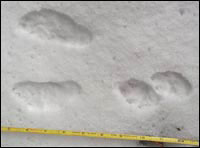
Snowshoe hare tracks.
Photo: Cascadia Wild!
Starting along the line of forest nearest the stream, I tangle and untangle myself in the heavy cover of the small subalpine fir, mountain hemlock, lodgepole pine, whitebark pine, and red alder. Success. Snowshoe hare tracks, as well as Douglas squirrel tracks, begin appearing everywhere. Amazingly, one snowshoe hare decides to depart from cover and bounds directly out into the sparse forest. Alarmed by this unusual tactic for a common forest prey creature, I follow. Surely, this hare risked many kinds of death — by owl, bobcat, marten, fisher, cougar, lynx and others — by making this dash. Perhaps not. Perhaps in this stark landscape, in this forest cathedral, the carnivores are so diminished that our large-footed friend knew she was safe in her journey.
Maybe she was scared in this direction. But as I continue to follow the tracks, I am unable to detect anything in pursuit. The tracks lead on, a full mile out into the semi-open plain of ivory flakes. Is this unusual? What is her home range? Later, at home, I will find in my field guide that the range is approximately 10 acres, but that hares will occasionally run a full mile. I am thankful for the stories arriving on the wind, full of ferocity and vision, but I also appreciate these diminutive elders built of tree bones, these collections of native naturalist stories we call field guides.
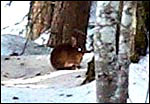
Rabbit run.
Photo: Cascadia Wild!
Much later in the day, I cross the tracks of a large elk. At first I wonder if it’s a bull or a cow, and then I smell it. The air reeks with an unmistakable pungency, the fresh passing of an antlered elk. I continue following the long striding tracks, while intermittently marking spots with the GPS to record data for later. I sense the animal knows I am there; it hears me, it feels me on its trail. Obsessed with following this creature, I run in the cold mountain air, mystified and ultimately curious about its being, its life. I follow it through dense stands of forest, shrubby red alders blocking the way, through open areas, across streams, down slopes, and further down the mountain. The elk has stopped to urinate, and the urine is fresh. Its smell is milder than the musk on the air, which comes and goes as I trot along the trail. I know elk habits, and I know he could run for five, 10, or 20 miles if he wanted to, and yet I’ve only covered two.
Despite the cold, my blood warms and I feel the instincts from a childhood hunting in the hills of Appalachia. I’m tracking, but now I’m hunting, too. I develop an affinity for this elk, a strange bond between the hunter and the hunted. But I don’t have a rifle, and the long-ago abundance of the creatures in this forest has diminished. We are no longer a hunter-gatherer culture; besides, it’s not the season to hunt anyhow. I hear the roar of a river nearby as I examine three whitebark pine needles clipped down to an inch, pointed in the center — they don’t look like snowshoe hare chews. Elk or deer? They appear old by the browned tips. The elk chooses to continue on across the river. And with darkness coming on, I turn away, up the drainage.
All this day, forest carnivores are nowhere to be seen. Have I chosen a poor site, or perhaps the wrong elevation, or an area with inadequate vegetation? I know the human impacts this forest has sustained from excessive logging and road-building, and I wonder: What is our connection to the unseen? How many of us would it take to call the animals back? What gifts would you leave for the sacred? What gifts would you leave for the forest carnivores, to show the tracks, to tell the stories to your grandchildren?
Tuesday, 13 Mar 2001
MT. HOOD, Ore.
Two smashed Palm Pilot computers, a lost Motorola radio, a screaming power-steering belt, the worst snow year on record, a malfunctioning GPS longitudinally stuck between la-la-land and Kalamazoo, the coldest cabin on the face of the known planet, and zero lynx tracks: not such a bad morning for an itinerant nonprofit tracker. But now, with my hand slowly slipping from the mass of roots above my head, my body dangling at the top of the icy, precipitous slope, I start to wonder if it was all worth it. However, this thought momentarily deserts my frozen brain for something more immediate — survival. Plummeting down the yawning abyss had shocked me more than scared me. The slide could have become a life-threatening tumble without some timely assistance: The last two trees stood two and four feet tall, and yes, I love lodgepole pine even more after today.
I stand up, one snowshoe dangling guiltily while my knees shake to hide their embarrassment. Life never seems so real and present as when the fragility of existence comes into view. So why am I here now, using my snowshoes as ice axes, kicking steps, and still descending the wind-tortured canyon that just attempted to mold me into a Rorschachian ice sculpture? Fresh fox tracks.
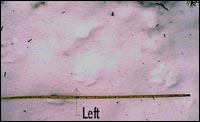
Fox tracks.
Photo: Cascadia Wild!
And today was the day for fox tracks, fresh ones and lots of them. Having already descended and ascended Sand Canyon in my pursuit of pine marten and snowshoe hare tracks, at first I balked at the ominous Little Zigzag Canyon. But, hot on the trail of the red fox tracks, I could not pass up the delicious opportunity to follow them as far as my body would allow. You see, given the good conditions and the light snow, I thought I could perhaps follow this fox to its den, spirit willing — to begin to pull at the thread of this tapestry, to start to unravel the mystery behind the movements of this animal. This was more than I could pass up for fear of a mere 300-foot icy canyon.
I traipsed back and forth across the hill and finally ascertained the animal’s route. Leading up the opposite slope, the tracks intersected those of another fox, and perhaps another. The tree where one fox had stopped was damp. I knelt to smell it, and the stink of a skunk greeted my nosebuds. The way the fox lifted its leg in relation to its back feet indicated that the urine was likely from a male fox. Interestingly, during my day’s sojourn following the fox, I noticed he would often stop twice within 100 feet to scent-mark a small Pacific silver fir or stump.
As the trail wound further uphill, I began to marvel at the stamina of this animal — apparently the fox had easily traversed the steep inclines of Little Zigzag Canyon, and then trotted continuous
ly upward. I eventually left the fox around 5,300 feet, which meant it had briskly ascended more than 1,000 feet in elevation gain in the time I followed it. I, on the other hand, was doing my best impersonation of an underwater smoker’s cough.
Toward the end of the day, the snowflakes grew larger and threatened to fill in the tracks, so I continued on, eating my lunch on the run. I must have been quite a sight for sentinel squirrels silently observing my approach: stumbling along in my snowshoes, fatigued, with frozen meat hooks for hands, gasping for breath, choking on dry bread glazed with peanut butter.
Coming upon two new fox trails intersecting the one I trailed, I was caught off guard by the amazing activity in this small area. Tracks seemed everywhere at once: up and down little hillocks, patches of snow almost stamped down, small trees circled multiple times. My mind raced as I tried to determine what had happened at this spot. Two foxes, maybe three … what were they doing? Were they hunting something? How old were the tracks? I walked the perimeter twice to see where the new animals came in and left. Something registered subconsciously: trees circled. I glanced at the small silver fir wearing a wreath of fox tracks around its base. Of course! They were playing, they were greeting each other and enjoying life, celebrating each other with the sheer joy of being alive. The foxes had displayed the pure essence of living, in much the same way I had struggled all day to follow their tracks.
Wednesday, 14 Mar 2001
MT. HOOD, Ore.
Dave and I arrive at the trailhead at 9:00 a.m., still buzzing from the green tea we drank on the ride over from Portland. Soft snow conditions fuel our tracking appetites as we stand at the base of the hill that ascends into the Badger Creek Wilderness Area. As the most remote and least-used area in the Mt. Hood National Forest during the winter, Badger Creek offers the best wild area for lynx and wolverine to roam. Our ascent begins easily in the fresh snow and then turns treacherous as we climb upward on the dim, icy trail through forests of ancient western hemlock, western red cedar, and ponderosa pine. Finally, we are forced to don snowshoes; their crampons offer us moderate traction on the slope, instead of coccyx-cracking falls.
We reach the ridge — the border of the wilderness area — just when I think my body might burst from the exertion. Immediately, we know the wilderness area has been doing its part for biodiversity; we find tracks we have not seen earlier in the day — snowshoe hare, Douglas squirrel, and bobcat!

A perfect bobcat track.
Photo: Cascadia Wild!
We stop, measure the bobcat tracks, and mark them on the GPS and in the notebook. We examine the overall shape of the track to distinguish it from a coyote or fox track. Is it more round than oval-shaped? Yes. The approximate length and width measurement is 1 7/8 inches by 1 7/8 inches, which falls in the range of typical bobcat track measurements. Are there claw marks repeatedly showing in the track? No. This could be an indication of a feline versus a canine, since felines have retractable claws. What does the gait look like? Interestingly, even in areas of shallow snow there appears to be an extra mark, as if the bobcat were dragging its toes. This is unusual, for most forest predators are masters of energy conservation, maintaining precise gaits with the cadence of a metronome. Maybe the bobcat was carrying something in its mouth? A snowshoe hare, perhaps?
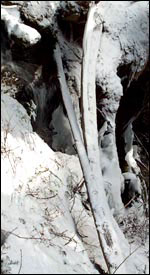
Bobcat tracks on a log.
Photo: Cascadia Wild!
It is noon and we decide to follow the bobcat trail as far as we can. The bobcat leaves the wilderness area — ignoring our human boundaries — and continues down the slope back toward the valley. It basically drops straight down the side of the mountain, as if it had a destination or a meeting in mind. By 3:00 p.m., we have followed the trail to reach a patch of woods near a mountain stream. In the woods, the cat, which seems to be a male, appears to have encountered another bobcat (likely a female, judging from the smaller tracks) that had been lying under a western hemlock tree. We can see the four- to five-hour-old tracks where she had approached the tree, and then we see the depression in the foliage where she had lain waiting.
As far as we can tell, the female stood up when the male bobcat arrived, and he followed her across a log, sniffing her. She continued across the creek, while he circled a small tree and dropped a scat where she had been standing. He then crossed the creek 30 feet downstream, delicately walking across a slippery, snow-covered log with a snowshoe hare in his mouth. Across the creek, the telltale toe drag tells us he was still carrying his dinner. The two bobcats paralleled each other on the slope as they disappeared into what Dave calls “the best habitat to lose a human in,” a rough-and-tumble jackstraw landscape that will have to wait for another day.
Thursday, 15 Mar 2001
PORTLAND, Ore.
It’s 7:30 a.m., and I roll in front of the computer after my morning Chi Kung energy exercises. Today’s poor snow conditions confine me to the office to complete overdue organizational work and planning. Not every day can be filled with inspiring tracking sessions in the deep forest. In fact, the tracking sessions are the highlight of my year — the payoff for nine months of organization, instruction, grant-writing, and volunteer coordination.
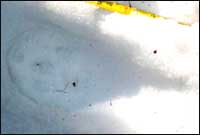
A bobcat track.
Photo: Cascadia Wild!
I download Global Positioning System way points gathered in previous days from the Garmin Etrex unit to a database spreadsheet, adding appropriate data from the field notebooks. The GPS data are important for mapping the location of forest carnivores in the national forests. I generate a dBASE file of the latest updates to send to a volunteer who is compiling our data in a Geographic Information Software (GIS) program called ArcView. Using this program, we will be able to perform sophisticated data analyses on our tracking transects. After that, I finish composing a few pages in the background section for the report we are writing for the U.S. Forest Service, U.S. Fish and Wildlife Service, and conservation groups (Oregon Natural Resources Council, Oregon Wildlife Federation, Predator Conservation Alliance). Then I upload the pictures of animal tracks from the digital camera and post some of them on our website.
Next, I call conservation organizations that monitor timber sales in the Mt. Hood National Forest. We talk about forming a partnership to train volunteers as animal trackers and naturalists, equip them with GPS units and notebooks, and send them to upcoming timber-sale locations. The volunteers would scout the forest to map animal movements through the area proposed for logging. Then, the data would be mapped with GIS tools. There is a lot of interest from volunteers and conservation organizations in this type of partnership with Cascadia Wild!
Lunch?
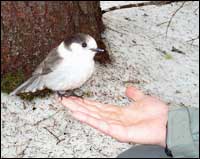
Bird in the woods.
Photo: Cascadia Wild!
I spend an hour completing a Juan Young Trust grant proposal to provide naturalist education opportunities for low-income, inner-city studen
ts in the Portland area. The scheme I’m proposing, the Nature Awareness Project, focuses on teaching animal tracking, the language of the birds (based on the concept that the birds are the alarm system of the forest that let you know where the predators are), nature awareness, and wilderness survival skills. Portland’s youth do not have many opportunities for study in the natural world, and it is our mission to take them on field trips designed to stimulate an inspiring connection with nature. I send emails and make follow-up phone calls to teachers to discuss goals and scheduling of field trips and in-class sessions for the spring.
I call one of our board members, Heather, to discuss the Academy of Native Arts and Science — our pilot project for a community school for youths. Hopefully opening this year, ANAS will be a school centered on naturalist education and built on models of tribal cooperation to inspire both the students’ interests and the instructors’ strengths. The five-member planning team has been making progress, and advertising for students should begin soon. The curriculum and educational models have been designed to include animal tracking, rites of passage, the language of the birds, and instructor-student projects involving tracking, restoration, and nature monitoring.
Uggh, tax forms. I spend two hours sifting through documentation and preparing our federal tax return for the organization. Then I glance at the state forms for about 10 nanoseconds before becoming ill, and I move on to something else. I scan-in more photos from the tracking project and from last summer’s camps. I will put the photos from the day camps, taken by volunteers, on the web page both for the grant foundations that provided funding and for prospective students.
A full day. Not quite as fun as tracking, but important work, no doubt.
Friday, 16 Mar 2001
MT. HOOD, Ore.
Our quest for tracks this week has been part of the Lynx Tracking Project. With this collaborative effort by Cascadia Wild! and Portland’s Metro Parks and Green Spaces, we hope to train volunteers to learn more about forest carnivores in the Mt. Hood National Forest. Volunteers may then be able to participate in a snow-tracking survey to locate tracks of the rare Canadian lynx.

A stripped cedar along the track.
Photo: Cascadia Wild!
Today, I’m out near Mt. Hood again. The snow cover crunches beneath my feet, as if I’m walking on children’s cereal frozen in the 4-degree temperature of the surrounding air. Searching for tracks in these conditions resembles hitchhiking on a road full of family minivans — parents driving, glossy-eyed and white- knuckled, discreetly choosing to see your haggard visage as something besides a person, perhaps a stop sign. Not much luck finding tracks at this elevation. The snow fell two days ago, and then the sun fried it all day yesterday. Hardened overnight, the crust is too hard to show tracks.
On a hunch, I try the nearby ridge. I climb, groan, moan, and struggle, but the ridge remains indifferent to my advances. Long troughs of snow lie behind me like snakes undulating crazily backward, running to lower ground. The higher elevation holds a reward: Right here, in the middle of the ridge, this same ridge I could have fallen down, I find marten tracks. They seem to have tumbled out of the marten’s pocket as it ran away. The animal shifted and dodged across the landscape, carving a sinuous path up and down the steep mountainside. Pine martens, cousins of the weasel and the wolverine, are ferocious predators, and today I am at the whim of this one’s route, darting down and then up the mountain searching out holes. I record GPS coordinates as I follow its trail. At one point, it climbed a tree and took a flying leap, leaving a full body cavity imprint in the snow. Wow, it looks like this marten was having fun! At the lower end of its trail, the tracks circle a log many times and then disappear. The tracks from the day before tell me I am near the den site, so I sit waiting as darkness descends, hoping for a glimpse of my friend, the marten.

